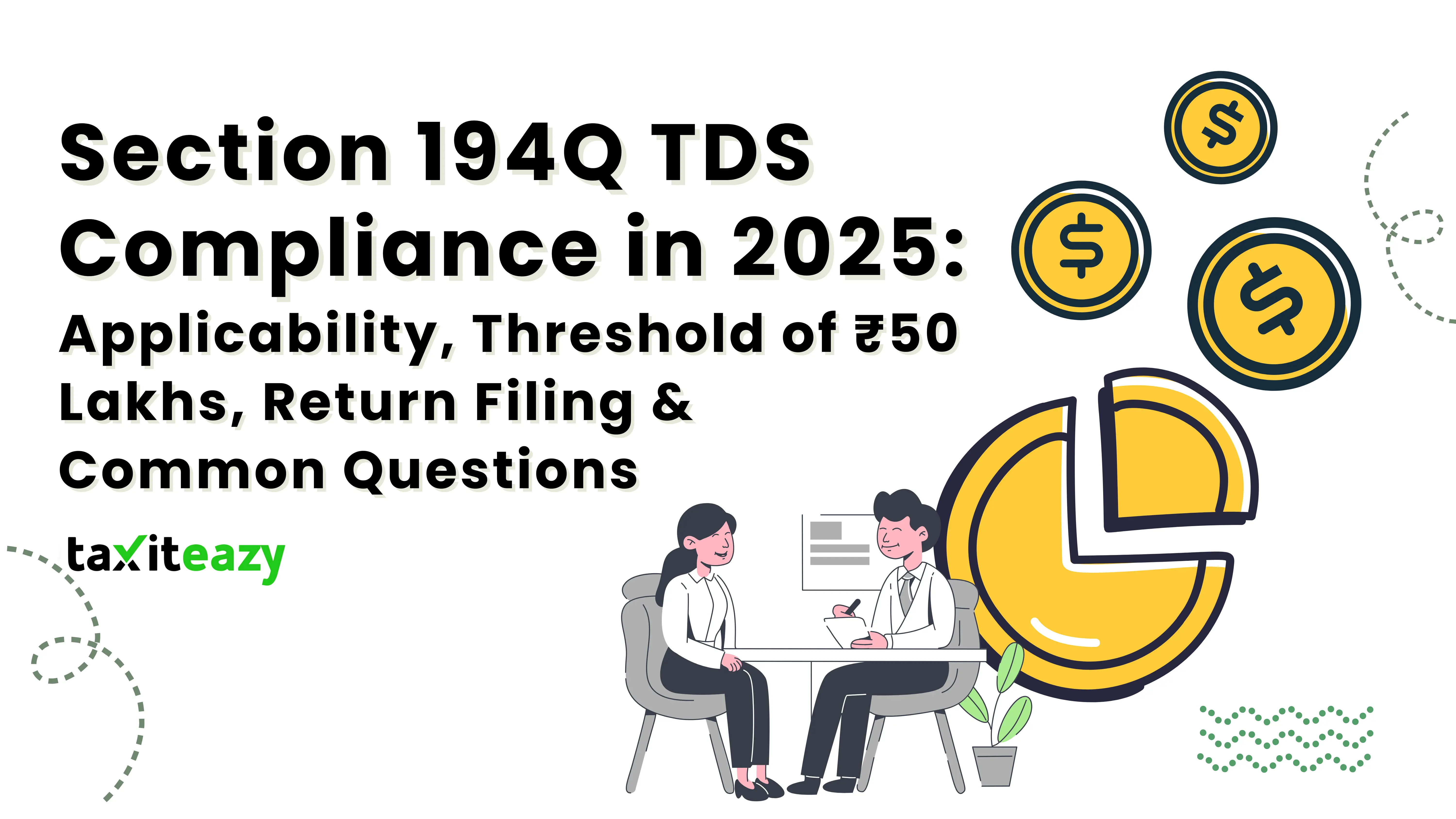CA Rishabh Mehta August 16, 2025
At TaxItEazy , we regularly guide businesses, CFOs, and compliance teams on evolving tax provisions. One area that has generated frequent queries is Section 194Q of the Income Tax Act – dealing with TDS on purchase of goods.
Introduced in Finance Act 2021, 194Q has significant implications for businesses crossing the ₹50 lakh threshold in purchases from a single seller. With recent clarifications and upcoming changes effective 1st April 2025 , it's crucial for businesses to understand applicability, compliance procedures, rate structure, and practical scenarios.
This guide is designed to be your single reference resource – detailed enough for compliance officers, yet explained in a way business owners can act on immediately.
📌 What is Section 194Q?
Section 194Q mandates that any buyer of goods is required to deduct TDS @0.1% when:
The value of goods purchased from a seller in a financial year exceeds ₹50 lakhs .
The buyer's turnover (gross receipts or sales) from business in the preceding financial year exceeds ₹10 crores .
Thus, the liability is on the buyer (not the seller).
📊 Applicability Conditions
Criteria
Requirement
Buyer's turnover (preceding FY)
Must exceed ₹10 crore
Purchase from seller
Exceeds ₹50 lakh in current FY
Type of goods
Any goods (except those specifically exempted like petroleum, electricity, etc.)
TDS rate
0.1% (5% if PAN not provided)
Effective from
1st July 2021, with amendments from 1st April 2025
🔢 Calculation of Threshold (₹50 Lakh)
The ₹50 lakh threshold is calculated per seller, per financial year.
Example:
Buyer turnover in FY 2024-25 = ₹12 crore ✅ (condition satisfied)
Purchases from Seller A: ₹70 lakh
Purchases from Seller B: ₹40 lakh
TDS applicability:
On Seller A → ₹70 lakh – ₹50 lakh = ₹20 lakh → 0.1% of 20 lakh = ₹2,000
On Seller B → Not applicable (as total < ₹50 lakh)
🧮 How to Deduct TDS u/s 194Q?
Track all purchases from each seller.
Once the total crosses ₹50 lakh, start deducting TDS on the excess amount.
Deduct at time of credit to seller's account or time of payment (whichever earlier).
Deposit TDS with the government using Challan ITNS 281.
File Form 26Q for TDS return.
📑 Compliance Checklist for Buyers
✅ Verify turnover of preceding year (should exceed ₹10 crore).✅ Track cumulative purchases seller-wise.✅ Deduct TDS only on amount exceeding ₹50 lakh.✅ Collect and verify PAN of sellers.✅ Deposit TDS monthly.✅ File quarterly TDS return (Form 26Q).✅ Reconcile with Form 26AS and seller's GSTR-2B for accuracy.
⚖️ Interaction with Section 206C(1H)
Both 194Q (TDS by buyer) and 206C(1H) (TCS by seller) deal with high-value transactions of goods. To avoid double levy, CBDT clarified:
If both 194Q and 206C(1H) are applicable, then 194Q (TDS by buyer) will prevail.
Seller should not collect TCS if buyer has already deducted TDS.
🔄 Common Exemptions
Transactions where TDS is already deductible under other sections (e.g., 194C for contracts).
Transactions in securities, commodities traded through recognized exchanges.
Imports from outside India (no resident seller).
Fuel, electricity, and certain notified goods.
📌 What's Changing from April 2025?
From 1st April 2025 , amendments clarify:
Scope of goods covered under 194Q (more detailed exclusions).
Stricter penalties for non-deduction.
Real-time cross-verification with seller's 26AS and AIS.
Higher TDS (up to 5%) in cases of non-filing of ITRs by seller.
This makes compliance tracking more important than ever.
📉 Consequences of Non-Compliance
Disallowance of expenditure u/s 40(a)(ia) (30% of purchase not allowed as expense).
Interest @1%/1.5% per month on late deduction/deposit.
Penalty under 271C equal to TDS not deducted.
Prosecution in extreme cases.
🧾 Example Scenarios
Case 1 – Regular Purchase
ABC Ltd (turnover ₹15 crore in FY 24-25) purchases ₹80 lakh worth of goods from Supplier X in FY 25-26.
First ₹50 lakh → No TDS
Next ₹30 lakh → TDS = ₹3,000
Case 2 – PAN not available
If Supplier X fails to provide PAN → TDS @5% = ₹1.5 lakh (instead of 0.1%).
💡 Practical Implementation (ERP / Tally)
Configure Tally Prime / SAP / Oracle ERP to auto-track seller-wise threshold.
Use deductee master records to store PAN status.
Generate monthly compliance reports for accounts payable team.
❓ Frequently Asked Questions (FAQs)
We've compiled FAQs including those most searched on Google ("People Also Ask") to address real-world queries:
It's cumulative per seller, per financial year. Purchases up to ₹50 lakh exempt; TDS applies only on excess.
Form 26Q is the quarterly TDS return where details of deductions under 194Q are reported.
No, it has been applicable since 1st July 2021. However, amendments are effective from April 2025.
Non-compliance leads to interest, penalty, and disallowance of expenses u/s 40(a)(ia).
Buyers with turnover > ₹10 crore in preceding FY, purchasing goods worth > ₹50 lakh from a seller.
Only 0.1% of the excess is deducted (5% if PAN not provided).
(Explained above under Example Scenarios).
194Q = TDS by buyer, 206C(1H) = TCS by seller. If both apply, 194Q prevails.
No, excluded as per CBDT circular.
No, if 194C (contract) applies, 194Q won't apply.
Stricter reporting, higher TDS for non-ITR filers, better tracking.
If conditions are met, TDS is mandatory. However, sellers can claim credit in their ITR.
No, securities and imports are excluded.
Seller gets the credit of TDS in their 26AS; buyer just deducts and deposits.
Enable TDS feature in Tally → Create party ledger → Set threshold → Configure 194Q at 0.1%.
Seller can claim refund (if excess deducted) while filing ITR.
🔗 Related Sections
Many businesses confuse Section 194Q with other provisions. For clarity:
194NF / 194N → TDS on cash withdrawals (not related to purchase of goods).206C(1H) → TCS on sale of goods (applies to seller, but overridden by 194Q).194C → TDS on contractual payments (mutually exclusive with 194Q).
👉 Read our in-depth guide here: Section 194NF Explained – TaxItEazy
🏢 Closing Thoughts – TaxItEazy's View
At TaxItEazy , we've seen multiple businesses fall into compliance traps – either by double deduction with 206C(1H), or by missing seller-wise purchase tracking. Section 194Q may look simple, but in practice, it requires robust ERP integration, timely monitoring, and proper documentation.
Our professional advice:
Review vendor-wise purchases monthly.
Automate compliance in ERP.
Keep documentation of PAN, ITR status, and agreements.
Seek professional consultation if in doubt.
💡 With amendments from April 2025, this section will see stricter enforcement. Staying compliant now will save future litigation and penalties.





